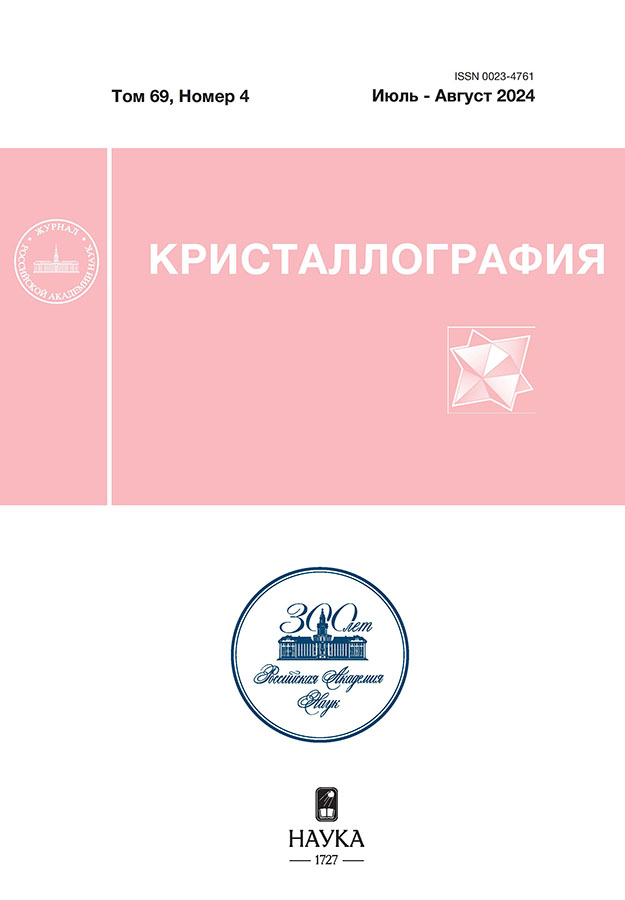Fast numerical calculation of X-ray diffraction from crystal microsystems
- 作者: Punegov V.I.1, Malkov D.М.1
-
隶属关系:
- Federal Research Center “Komi Scientific Center, the Ural Branch of the Russian Academy of Sciences”
- 期: 卷 69, 编号 4 (2024)
- 页面: 575-580
- 栏目: ДИФРАКЦИЯ И РАССЕЯНИЕ ИОНИЗИРУЮЩИХ ИЗЛУЧЕНИЙ
- URL: https://ter-arkhiv.ru/0023-4761/article/view/673145
- DOI: https://doi.org/10.31857/S0023476124040021
- EDN: https://elibrary.ru/XDWGDS
- ID: 673145
如何引用文章
详细
In the kinematical approximation, a method for rapid numerical calculation of X-ray diffraction from thin crystalline microsystems has been developed. The speed of calculating of reciprocal space maps using this approach is three to four orders of magnitude higher than calculations based on the Takagi–Taupin equations or two-dimensional recurrence relations. Within the framework of the obtained solutions, numerical simulation of X-ray reciprocal space mapping was performed for three models of crystal chips of microsystems.
全文:
作者简介
V. Punegov
Federal Research Center “Komi Scientific Center, the Ural Branch of the Russian Academy of Sciences”
Email: vpunegov@dm.komisc.ru
Institute of Physics and Mathematics
俄罗斯联邦, SyktyvkarD. Malkov
Federal Research Center “Komi Scientific Center, the Ural Branch of the Russian Academy of Sciences”
编辑信件的主要联系方式.
Email: vpunegov@dm.komisc.ru
Institute of Physics and Mathematics
俄罗斯联邦, Syktyvkar参考
- Neels A., Bourban G., Shea H. et al. // Proc. Chem. 2009. V. 1. P. 820. https://doi.org/10.1016/j.proche.2009.07.204
- Neels A., Dommann A. // Techn. Proc. NSTI-Nanotechnology, 2010. (Conference and Expo, Anaheim, USA, 21–24 June 2010.) V. 2. P. 182.
- Schifferle V., Dommann A., Neels A. // Sci. Technol. Adv. Mater. 2017. V. 18. P. 219. https://doi.org/10.1080/14686996.2017.1282800
- Punegov V.I., Pavlov K.M., Karpov A.V., Faleev N.N. // J. Appl. Cryst. 2017. V. 50. P. 1256. https://doi.org/10.1107/S1600576717010123
- Punegov V.I., Kolosov S.I. // J. Appl. Cryst. 2022. V. 55. P. 320. https://doi.org/10.1107/S1600576722001686
- Punegov V.I., Kolosov S.I., Pavlov K.M. // Acta Cryst. A. 2014. V. 70. P. 64. https://doi.org/10.1107/S2053273313030416
- Punegov V.I., Kolosov S.I., Pavlov K.M. // J. Appl. Cryst. 2016. V. 49. P. 1190. https://doi.org/10.1107/S1600576716008396
- Takagi S. // Acta Cryst. 1962. V. 15 P. 1311. https://doi.org/10.1107/S0365110X62003473
- Taupin D. // Bull. Soc. Fr. Miner. Crist. 1964. V. 87. P. 469.
- Stepanov S., Forrest R. // J. Appl. Cryst. 2008. V. 41. P. 958. https://doi.org/10.1107/S0021889808022231
补充文件














